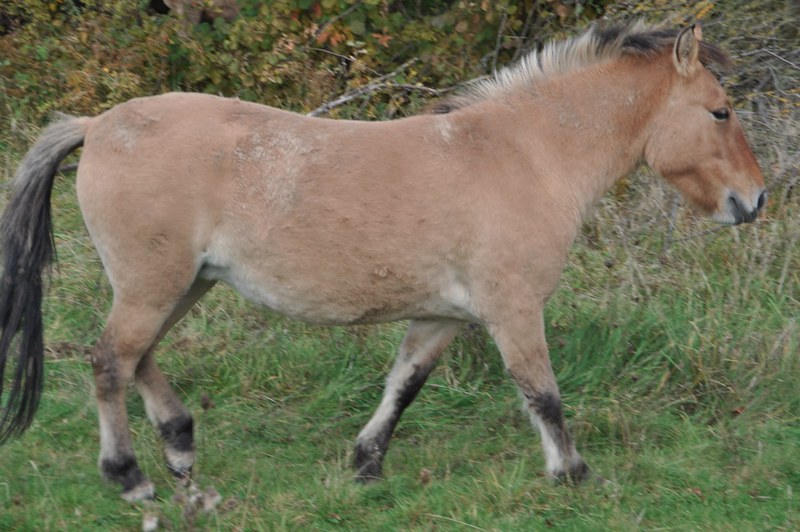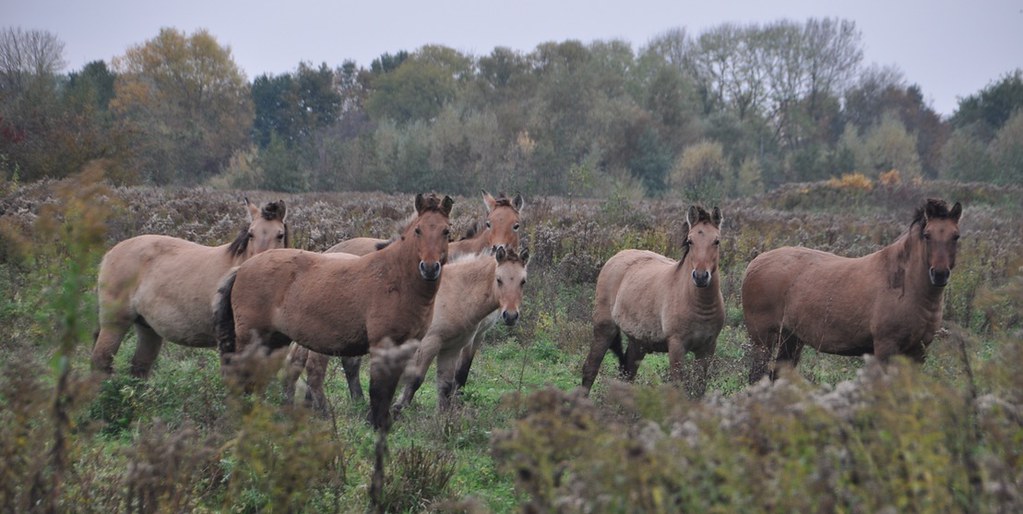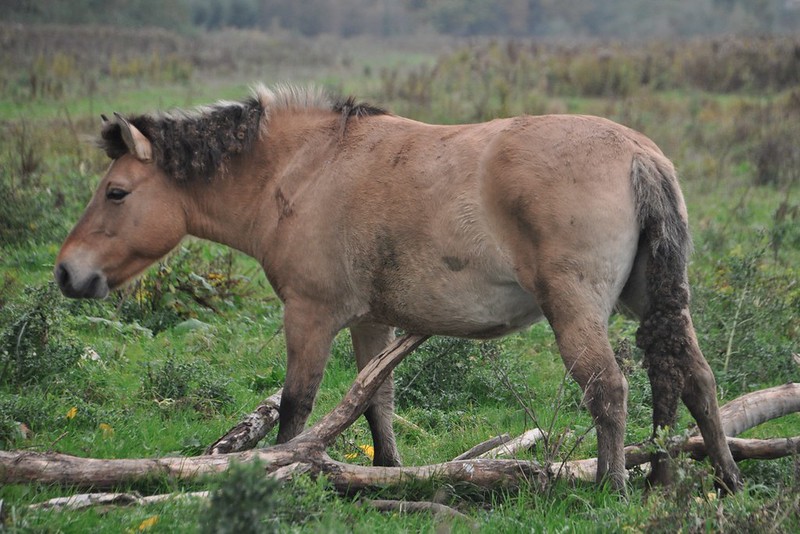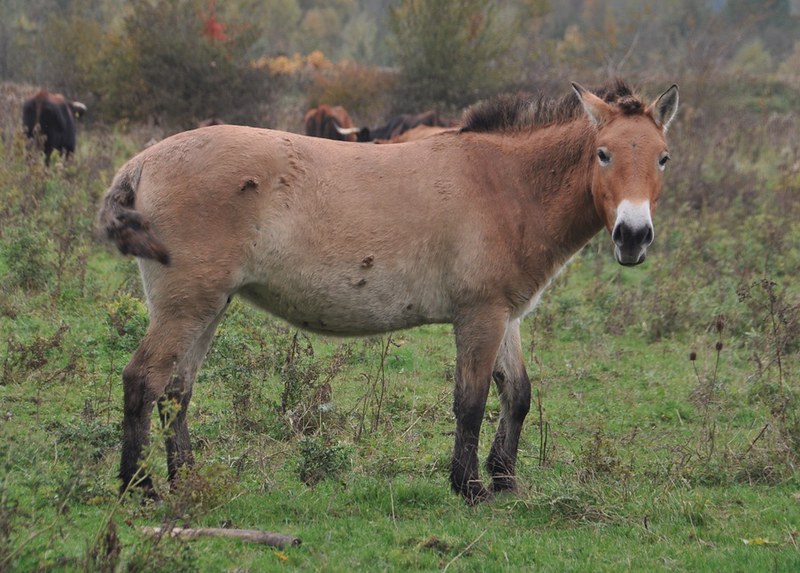As it is the case in so many reserves for landscape conservation, horses and cattle share the area because they complement each other in their grazing activity and both are native species. I don't know the total number of horses in the Lippeaue, perhaps about 40 individuals but that is only a guess.
The horse herd at Disselmersch consists of mostly pure Koniks, plus one Konik x Przewalski hybrid. The herd at Hellinghauser Mersch is, as far as I can see, completely mixed. They had a pure Konik stallion in the herd until at least 2013, but that one seems to be gone now. Now there are 50% Przewalski hybrids, 25% Przewalski and 75% Konik hybrids as much as a pure Przewalski mare. The 50-50 hybrids resemble a pure Przewalski rather close, except that the short mane is semi-erect and their head looks somehow more caballine. The colour of these Konik x Przewalski is phenotypically bay dun with countershading and a white muzzle (which seems, however, to be slightly reduced in these hybrids), which makes sense, since black (a) is recessive under bay (A+), which are the base colours for black dun and bay dun that we see in the Konik and Przewalski, respectively. The colour of the back-crosses with Koniks on the other hand is interesting to me. They should end up as either a//A+ or a//a with a 50% probability, so either the same colour as the first-generation hybrids or a pure Konik, yet at least a number of them has a colour that is somewhat more reddish and sooty than those of the first-generation hybrids. So there might be more than just one locus involved. Countershading and white muzzle are absent or strongly reduced in the Konik-backcrosses. The new dominant stallion seems to be one of those; the new generations will produce some further interesting animals because genetics will cause individuals that show mosaic traits of both horse types.
 |
| Mostly pure Koniks in the Disselmersch. |
 |
| Konik x Przewalski mare in the Disselmersch. |
 |
| Konik x Przewalski as much as 25% Przewalski 75% Konik crosses plus the pure Przewalski in the background. Hellinghauser Mersch. |
 |
| The pure Przewalski mare at the far left. |
 |
| A 25% Przewalski 75% Konik (?)stallion. Hellinghauser Mersch. |
 |
| Konik x Przewalski mare. |
 |
| The pure Przewalski mare, Hellinghauser Mersch. |
It is an open question whether or not Przewalski's horses can or should be introduced into European natural areas - it seems that the common opinion in rewilding projects and organizations is that European domestic horses are to be preferred over the P. horse. There are several reasons in favour of using domestic horses instead of the P. horse for rewilding:
- The Przewalski's horse is not the western, but Asian subspecies, whereas domestic horses are descendants of the western wild horse subspecies
- The P. horse is an animal of the steppe and adapted to arid climate, shown also by its standing mane (historic references for the European wild horse describe a short but never a standing mane), whereas native European landraces are adapted to the local climate.
- Przewalski's horses and caballine horses separated between 120.000 and 240.000 years ago, the P. horse has one more pair of chromosomes and one more thoracic vertebrae (see Wikipedia) - so whether or not you regard both these types of equines separate species or not, they diverged quite some time ago and developed some evident differences. Mixing both types, or introducing one into the range of the other, would eradicate these results of evolution.
But there are also arguments in favour of using the Przewalski's horse for European rewilding:
- The P. horse is a wild animal, exhibiting a behaviour that is authentic for a wild horse, including a high intra- and interspecific aggression potential but also shyness towards humans in nature, whereas domestic horses often still remain tame after several generations, with their obtrusive behaviour causing troubles with workers and visitors (see Bunzel-Drüke et al. 2008).
- With the possible exception of the standing mane as much as the lack of the allele for a black base colour (a), the Przewalski's horse itself matches the morphology and looks of the western European wild horse quite well, as much as a number of primitive landraces do, including the "small" size, sturdy body, robust head et cetera.
- Although it seems that the P. is a different ecotype than European wild horses and European landraces are, they seemingly do well in the climate of this continent. In grazing projects like the Lippeaue or Döberitzer Heide they show no sign of discomfiture.
- As long as pure animals are used, wild European populations of the Przewalski's horse would help preserving the subspecies.
That's why I proposed that a mix of local or suitable landraces combined with influx from Przewalski's horses (by using crossbreeds, not pure individuals) would be a perspective for re-stocking Europe's natural area with authentic horse populations in a 2013 post. Nowadays I am not so convinced of that proposal anymore. As outlined above, the Przewalski's horse and caballine horses developed some recognizable genetic, ecologic (including geographic) and osteologic differences during about 200.000 years of separate evolution.
Nevertheless, Przewalski's horses have already been introduced in European natural areas such as Tschernobyl or the Puszta in Hortobagy (the latter is especially reminiscent of their natural habitat in Asia), where they do well.
The stock at the Lippeaue, however, is not supposed to become a large, self-sustaining population in a barely regulated area one day. Neither did someone propose that Konik x Przewalski is the one and only equine model for Europe's natural areas. Instead, they are the "grazing tools" of a conservation project for the Lippeaue reserve, and these experimental hybrids fulfill their job well.
Whether you are in favour of Przewalski influence in grazing projects or not, it seems that many Koniks might have P. introgression already due to intermixing with Heck horses, which are kind of diluted Koniks with Przewalski influence and also look that way. In the 1970s, Przewalski's horses were crossed in again at the Wildpark Hardehausen, so that about the half of their stock has a standing mane today (see Bunzel-Drüke et al. 2008). Heck horses and Koniks are often mixed indiscriminately with each other, so that they are hard to distinguish at least in German grazing projects today. For a Konik/Heck horse with a standing mane revealing its Przewalski influence, go here for example.
Bunzel-Drüke, Finck, Kämmer, Luick, Reisinger, Riecken, Riedl, Scharf & Zimball: „Wilde Weiden: Praxisleitfaden für Ganzjahresbeweidung in Naturschutz und Landschaftsentwicklung“ 2008.

How about the Icelandic horse and Criollo? They very much have potential as horses bred for tough conditions.
ReplyDeleteHow important are the visual aspect vs. their functionality as a wild horse? Healthyness, resistance against elements, ability to live on scarce food etc.
ReplyDeleteHow much is known of the Konik horse as to having direct roots from the Tarpan? Is this genetically verifiable? And how much of their wild qualities have they lost? And how much might we really know about wether the Tarpans were already mixed with domesticated horses, which is a highly likely scenario.
Cave paintings show a way more diverse set of colourations than the brown-greyish appearance of the Konik. The third most common seem to share that of a leopard appaloosa. There is also a striped pattern often depicted that may have been lost in time, or maybe that is how they depicted brindle.
But i am thinking, the main goal should be a sustainable and healthy population, and perhaps shyness of humans which, as you suggested, the przewalski can help with. To be accurate with how they are depicted on cave paintings the leopard colouration type also need to be introgressed.
Really one of the absolutely toughest horse breeds out there period, is the Criollo, they thrive on little food and survive in heat and cold. They also have a strong immune system and arguably the best stamina in the horse world. These characteristics are obviously acquired descending from Spanish war horses, having survived world wide voyages and in the wild of southern south America which both get's very hot and snowy, where it also needed to be wary of predators such as the Jaguar and mountain lion and have developed a strong immune system withstanding parasites prevalent in south american jungles. It's like this breed is just waiting to be benefited for a program like this. It would be ashame to overlook it atleast.
Other tough breeds are obviously the Yakutsk horse, whose ability to flee predators i question, and the Icelandic horse but these are primarily adapted to arctic conditions and especially the icelandic horses are very difficult to spook since they have no natural predators where they roam also they have been very isolated from disease.
If you want to get good results on this project there is basically a certain set of criterias, right? Build, colouration, and wilderness adaptability. Now for these criterias the Konik-Przewalski are probably closest to the real deal so far, but could definitely benefit from introgression of other tough breeds and diversification of their colour patterns. And the Criollo honestly could have real benefit to the resilience aspect. But i mean really, i don't think the Heck horses hold much more "wilderness qualification" than many other horses out there.
My 50 cents. And kudos for an interesting blog.
Some of your questions and points have been adressed on this blog already, you can browse the "wild horse" section, there are a couple of posts that cover those topics.
DeleteI am not particularly fond of those Heck horses either, they are basically just washy Koniks.
Has it been tried to cross a Przewalski horse with a donkey ?
ReplyDeleteWith how many chromosomes would a foal end up ?
If it would be 64, maybe a ~true hybrid may be the result...?
(sorry if this is a double-posting, unsure if it was send already. and preview does't work)
If these 1/2 Przewalski-crosses would be crossed with mongol horses the offsprings would be 1/4 Przewalsi and 1/2 mongolian.
ReplyDeleteAnd if these would be crossed to the original pool it would result in 1/8 Przewalski and 1/4 mongolian.
Crossed back to the previous generation the result would be 3/16 Przewalski and 3/8 mongolian.
Maybe this would be the most true thing wich could be done to horses...they should be somewhat wild and have a healthy gene-pool.
I have been consulting this entry out of interest in the results of hybridizing domestic and przewalski's horses. I am glad I did because it provided inspiration for one of the more recent posts on my blog. If you would take the time to read it at some point I would love to know what you think. http://rewildcanada.blogspot.ca/2016/07/possible-breeds-to-be-used-in-creation.html
ReplyDelete